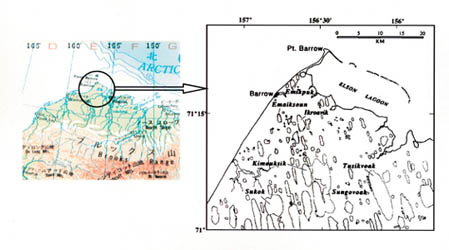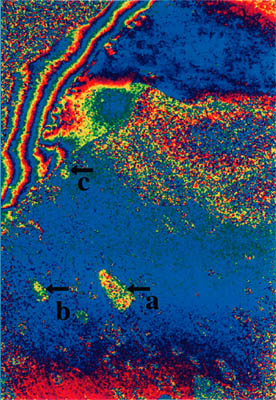9. Snow and Ice related Research
Detection of Ice Thickness Change Using InSAR
Fig. 1: Detection of ice thickness change for lake ice using JERS-1 SAR interferometry.
(Click to View Enlarged Image)
 Figure 1 indicates an ice thickness change of lake ice in northern Alaska observed by JERS-1 interferometric SAR. There are plenty of shallow fresh water lakes called "tundra lakes" in this area. The lake water starts to freeze in September and the lake ice grows during the winter. The thickness of lake ice may exceed 2 meters at the end of the winter season. The dominant microwave scatterer from the lake ice was proven to be the bottom surface.
Figure 1 indicates an ice thickness change of lake ice in northern Alaska observed by JERS-1 interferometric SAR. There are plenty of shallow fresh water lakes called "tundra lakes" in this area. The lake water starts to freeze in September and the lake ice grows during the winter. The thickness of lake ice may exceed 2 meters at the end of the winter season. The dominant microwave scatterer from the lake ice was proven to be the bottom surface.
A repeat pass interferometric SAR can acquire the phase difference of scattering during the time between two observations. Since the dominant scattering contains the microwave propagation through the ice, the derived phase difference has information related to the ice thickness change.
Figure 1 is the phase difference image derived from the data acquired on April 2 and May 16, 1993. By combining the analysis with an ice growth model, the thickness change during 44 days was found to be +8 cm at lakes a to c in the figure. This example indicates that the interferometric SAR can detect the change in internal microwave scattering of the targets.
Extract from the JERS-1 Earth View published by NASDA EORC
©JAXA EORC
